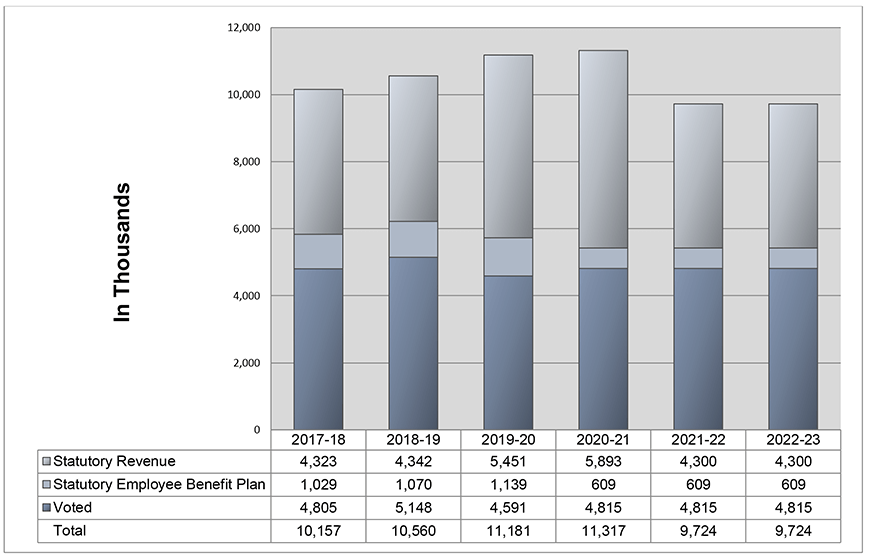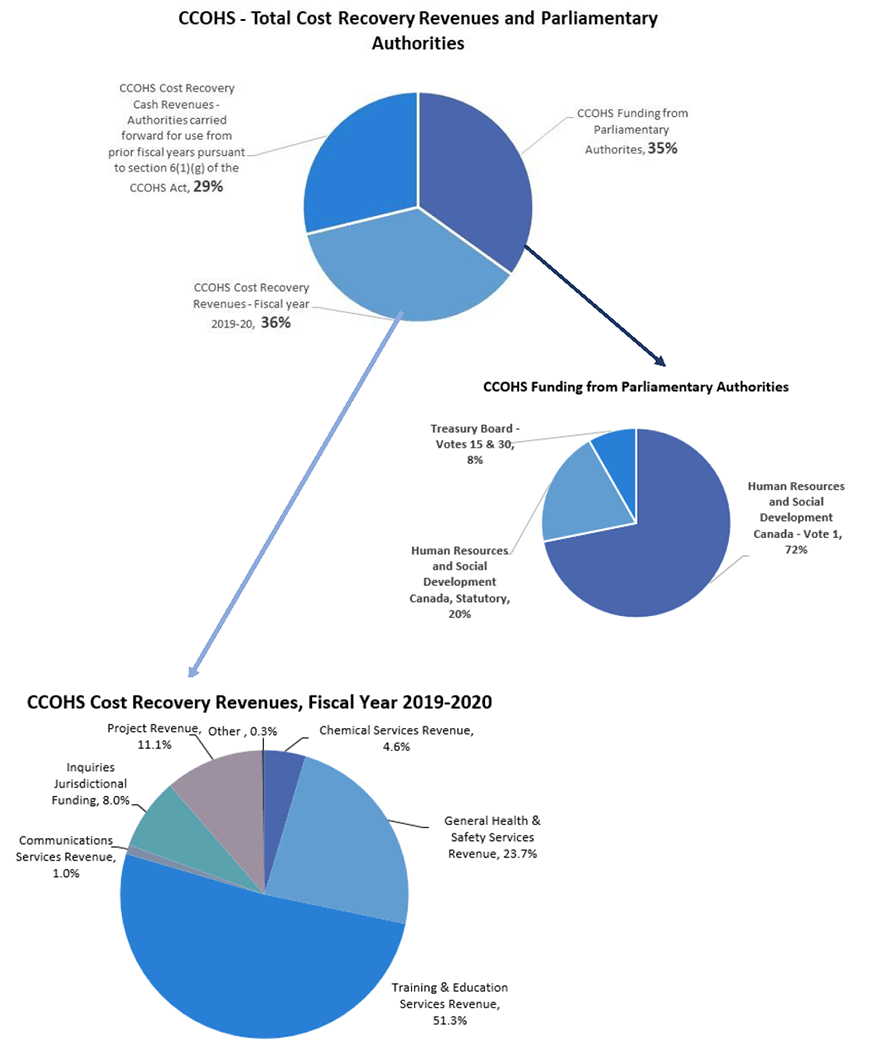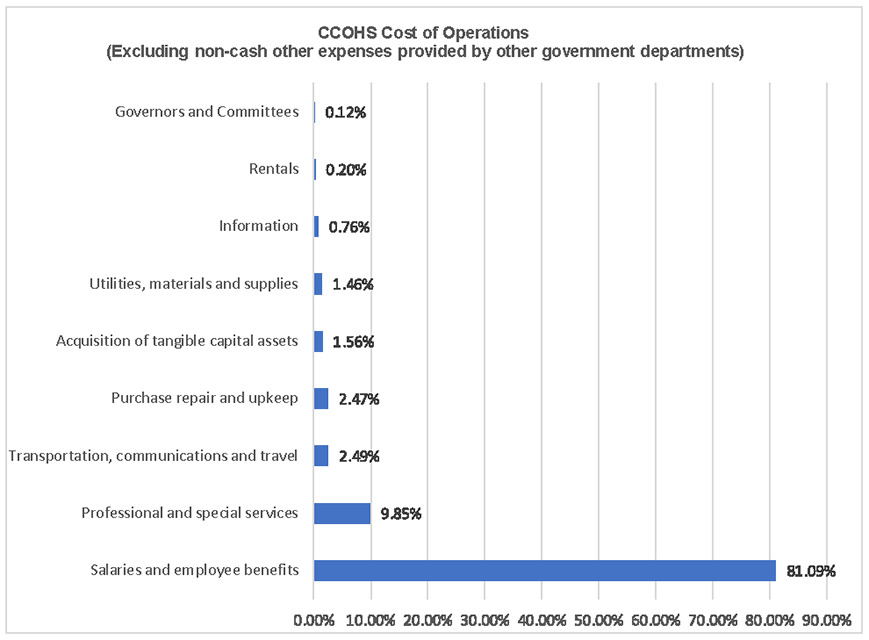Scheduled maintenance - Thursday, July 12 at 5:00 PM EDT
We expect this update to take about an hour. Access to this website will be unavailable during this time.
Complete a survey on your experience using this Departmental Results Report.

As Minister of Labour, I am pleased to present the 2019-20 Departmental Results Report for the Canadian Centre for Occupational Health and Safety (CCOHS).
For more than 40 years, as Canada’s national resource dedicated to advancing workplace health and safety, CCOHS has been a source of credible and unbiased information and quality tools for employers, workers, and stakeholders to help prevent injuries and illness in Canadian workplaces.
This past year the work of CCOHS centred on promoting safe work practices around priority workplace areas of concern that included mental health, impairment, harassment and violence, and occupational diseases. To do this, CCOHS collaborated and partnered with like-minded organizations and agencies across Canada to put occupational health and safety information into the hands of those who need it most.
CCOHS partnered with the Government of Canada on a national multi-faceted social media campaign to promote culture change around workplace harassment and violence. The campaign stressed the importance of developing policies and programs to prevent harassment and violence and educate the workforce on how to respond and report. The campaign was widely shared and potentially reached over six million.
With the onset of a global pandemic in March, our world was forever changed. CCOHS was already ahead of the crisis, updating resources and preparing business continuity guidance on how to plan for a pandemic. A microsite dedicated to providing access to COVID-19 resources was quickly made available and CCOHS, in collaboration with the Government of Canada, produced much needed occupational and sector-specific guidance for Canadians to post to the site.
CCOHS has developed relationships with Indigenous communities to learn about their unique needs and challenges that they may better be served. This year, CCOHS participated in multiple conferences and roundtables to exchange knowledge and share perspectives on mental health, leadership and occupational health and safety.
I look forward, especially during this global COVID-19 pandemic, to continuing our collaboration with CCOHS to offer programs, resources, and tools that Canadian workplaces need to safely navigate these extraordinary challenges and protect the health, safety and well-being of workers in Canada.
The Honourable Filomena Tassi
Minister of Labour

I am pleased to present the 2019-2020 Departmental Results Report for the Canadian Centre for Occupational Health and Safety (CCOHS).
With our five-year strategic plan as our roadmap, we continued our commitment to address current and emerging workplace safety concerns that included mental health, harassment and violence, impairment, occupational disease, and of course, COVID-19.
CCOHS has long recognized the importance of advancing workplace mental health in Canada. In partnership with the Mental Health Commission of Canada, we launched a mental health assessment tool, Caring for the Paramedic Community, to help paramedic organizations identify key areas of strength and concern that influence the psychological health and safety in their workplace. We created new courses to educate workers and materials to promote injury and illness prevention, and forged new relationships in the agricultural sector to address the mental health of farmers.
In addition to our partnership with the Government of Canada on a national multi-faceted social media campaign to help workplaces promote culture change around workplace harassment and violence, CCOHS offered workshops that promoted workplaces to take action on violence prevention policies and programs. Overall, participants appreciated the positive learning environment, and expect to impact more than 3,000 workers across Canada.
And then in January there was news about a deadly coronavirus. CCOHS was ready with the most current information on COVID-19 and business continuity planning. In March when a global pandemic was declared, businesses closed, workers went home to work remotely, and the essential workplaces that continued to serve needed information about COVID-19 and guidance on how to work safely. CCOHS partnered with the Government of Canada and other stakeholders to develop tips sheets for specific higher risk sectors and occupations. We unlocked relevant courses and publications and made them available for free on the CCOHS website and bolstered our Infectious Disease Outbreak web portal to provide central access to hundreds of credible resources from Canada and international agencies. We closed out our year very differently than how we began it, with most of our attention and efforts focused on COVID-19.
CCOHS will continue to focus on its commitment to serving all Canadians with the information, tools, and guidance to making their workplaces both mentally and physically safer, where everyone can thrive.
Anne Tennier, P.Eng., EP
President and Chief Executive Officer
$11,180,990
Actual Spending
83.3
Actual FTEs
For more information on the Canadian Centre for Occupational Health and Safety’s plans, priorities and results achieved, see the “Results: what we achieved” section of this report.
CCOHS is governed by a tripartite council representing governments (federal, provincial and territorial), employers, and labour organizations. The Council of Governors (Council) assists in overseeing a policy framework for a trustworthy and complete occupational health and safety service and ensures that the information CCOHS disseminates is unbiased. CCOHS’ Council members are directly involved in the policy, governance and strategic planning for the organization. Council also assists with reviews of programs and services to help ensure that CCOHS’ information is impartial and relevant. Along with federal government support, CCOHS’ inquiries service is supported and partially funded from contributions provided by provincial and territorial governments.
The goal of this public service program is to provide free information on occupational health and safety to support Canadians in their efforts to work safely and create healthy and safe workplaces. Citizens are provided information through a free and impartial personalized service via telephone, e-mail, person-to-person, fax or mail. Alternatively, they can independently access a broad range of electronic and print resources developed to support safety and health information needs of Canadians. This may include cost recovery products and services and is supported financially by contributions from various stakeholders.
Through health and safety information development, the Canadian Centre for Occupational Health and Safety collects, processes, evaluates, creates and publishes authoritative information resources on occupational health and safety for the benefit of all working Canadians. This information is used for education and training, research, development of policy and best practices, improvement of health and safety programs, achieving compliance, and for personal use. When the product or service provided by the Canadian Centre for Occupational Health and Safety is offered to identifiable external recipients with benefits beyond those enjoyed by the general public, the product or service becomes part of the cost-recovery program and a fee is charged.
The Canadian Centre for Occupational Health and Safety promotes and facilitates consultation and cooperation among federal, provincial and territorial jurisdictions and participation by labour, management and other stakeholders in the establishment and maintenance of high standards and occupational health and safety initiatives for the Canadian context. The sharing of resources results in the coordinated and mutually beneficial development of unique programs, products and services. Collaborative projects are usually supported with a combination of financial and non-financial contributions to the programs by partners and stakeholders and result in advancement of the health and safety initiatives.
CCOHS recognizes the importance of Gender Based Plus (GBA) and is committed to ensuring diverse groups of workers in Canada benefit from our GBA+ policies and programs. CCOHS leadership along with its tripartite Council of Governors ensure that GBA+ policies and programs are integrated into departmental decision-making processes, by requiring CCOHS to assess the potential implications of products and services produced by CCOHS to support the diverse populations of Canadians.
The Gender, Work, and Health website provides information and resources to help employers understand how the physical differences and psychosocial factors influence the rate of injury and illness among men, women, and non-binary people working identical jobs. This year, more than 15 relevant resources were added and the website served as a landing page for a social marketing campaign CCOHS deployed from January to February on the caregiver-inclusive workplace standard. As a result, the website had a surge in usage of 49% from the previous year. Usage of the resources on the site continues to grow as the resources are developed.
In 2019-20 CCOHS incorporated GBA+ initiatives in the following areas of decision making:
As a micro sized department, CCOHS does not have the capacity or resources to undertake experiments in order to achieve the results of the Centre’s core responsibility.
CCOHS’ goals for 2019-20 were to respond to the three strategic priorities by providing products and services that were easily accessible to employees and employers alike; increasing awareness of occupational health and safety issues; and promoting the advancement of workplace health and safety. To achieve these goals CCOHS identified harassment and violence, mental health, occupational disease, and impairment in the workplace as areas of focus.
The CCOHS website is the core vehicle used to deliver all of its products. During 2019-2020, the web topic pages on pandemics and Repetitive Strain Injury Awareness Day (RSI Day) were enhanced with additional tools. New projects and apps developed in partnership with other organizations were also made available through the CCOHS website. The website received over 13.2 million visits, from 9.9 million people, with 32% of site usage originating from within Canada. 84% of survey respondents said they used the information from this site to make changes in their workplace.
"We are a construction company using the information your staff has provided to set up a food processing plant where lift trucks and personnel will be traveling on a daily basis. This will benefit a few of our staff for informational purposes but will benefit approximately 30-40 staff that will be working in this new plant. The information is then very important to pass along to this particular company and another company where we are also in the process of setting up (building) which will be a large manufacturing plant."
Safety InfoLine, CCOHS’ free, confidential, person-to-person information service provides users with direct support. Available to all Canadians, CCOHS’ occupational health and safety specialists responded to 8,327 inquiries spanning across employers (49.5%), labour (33.6%), the general public (15.6%), and governments (1.3%) this past year. Survey results revealed that 84.4% of users were very satisfied with the information they received, and 68% indicated their use of information obtained from CCOHS would lead to current or future workplace changes designed to improve health and safety. The OSH Answers mobile app had 11,144 downloads.
This year, CCOHS shifted our focus on harassment and violence from awareness to action, sharing information on practical ways to prevent and address complaints and unacceptable workplace behaviours.
"I was very impressed with the completeness of the information provided and with the level of professionalism of the person I was connected with. Thanks!"
CCOHS continued to provide Canadians with reliable and credible information, tools, and resources on mental health in the workplace to affect positive change. In partnership with organizations across Canada, CCOHS produced tools for high risk industries such as health care to help workplaces assess the mental health of their organizations.
This year CCOHS focused on educating Canadians about the hazards and risks of various occupational diseases such as occupational cancers, respiratory illness, and coronaviruses, and how to prevent harmful exposure. When the Coronavirus (COVID-19) pandemic was declared on March 11, CCOHS was ready to respond to workplaces seeking guidance with free tools and resources such as the Flu and Infectious Disease Outbreaks microsite, Pandemic planning and Business Continuity Guide, fact sheets, newsletter articles, and sector specific tip sheets.
In October 2018, the Canadian government legalized the sale and use of recreational cannabis. To help Canadians address the potential for impairment in the workplace, CCOHS shared prevention messages across all social media platforms and made guidance documents, online courses, infographics, newsletter articles, and podcasts available.
"I am always impressed by the level of detail received in email responses from CCOHS to my questions. I have learned a lot and will use this information to beef up our health and safety procedures. I am developing a flow chart now and I think I will have more questions as I go, but as an answer to my initial questions, 5 stars! Thank you!"
| Departmental Results | Performance Indicators | Target | Date
to achieve target |
2017–18 Actual results |
2018–19 Actual results |
2019–20 Actual results |
|---|---|---|---|---|---|---|
| Canadians can easily access CCOHS’ occupational health and safety information and services. | Number of Canadian web sessions promoting occupational health and safety information | 3 to 4 million web sessions | March 2020 | 3,531,000 | 4,200,718 | 4,986,345 |
| Number of social media impressions promoting occupational health and safety information where CCOHS was referenced as the source | 1.5 to 1.9 million impressions | March 2020 | 1,906,795 | 2,246,613 | 2,474,648 | |
| Percentage of Canadian users of CCOHS’ website who indicated that information was easy to access. | 65 to 75 percent | March 2020 | Not available * | 80.3% | 85% | |
| Canadians have an increased awareness of occupational health and safety issues in the workplace. | Number of national media sightings promoting occupational health and safety information where CCOHS was referenced as the source. | 550 to 800 media sightings | March 2020 | 779 | 877 | 957 |
| Number of CCOHS podcast listens promoting occupational health and safety information. | 70,000 to 80,000 listens | March 2020 | 84,718 | 62,363 ** | 65,883 | |
| Percentage of Canadian users of CCOHS’ website who indicated that their awareness of occupational health and safety has increased as a result of the information and/or resources provided. | 65 to 75 percent | March 2020 | Not available * | 84.7% | 85.8% | |
| Occupational health and safety information is used to improve workplace practices. | Percentage of subscribers to CCOHS’ Health and Safety Report who say they use the information to make current or planned changes in their workplace that might improve occupational health and safety. | 60 to 72 percent | March 2020 | 76% | 71% | 66% |
| Percentage of Safety InfoLine users who say they use the information to make current or planned changes in their workplace that might improve occupational health and safety. | 60 to 65 percent | March 2020 | 65% | 66% | 68% |
* A new web survey was introduced in fiscal year 2018-19 to measure this result. Results were tabulated in April 2019.
** Old content was removed, approximately 30% of the total podcast collection, thereby impacting the number of listens.
| 2019–20 Main Estimates |
2019–20 Planned Spending |
2019–20 Total authorities available for use |
2019–20 Actual spending (authorities used) |
2019-20 Difference (Actual spending minus Planned spending) |
|---|---|---|---|---|
| 6,106,928 | 6,106,928 | 13,375,180 | 6,953,799 | 846,871 |
Actual spending for the program exceeded planned spending by $846,871 which primarily resulted from increased staffing costs for benefits; as well as increased spending on software and computer equipment to support additional cost recovery revenue projects.
| 2019–20 Planned full-time equivalents |
2019–20 Actual full-time equivalents |
2019–20 Difference (Actual full-time equivalents minus Planned full-time equivalents) |
|---|---|---|
| 68 | 62.3 | (5.7) |
Financial, human resources and performance information for the Canadian Centre for Occupational Health and Safety’s Program Inventory is available in GC InfoBase.
Internal Services are those groups of related activities and resources that the federal government considers to be services in support of programs and/or required to meet corporate obligations of an organization. Internal Services refers to the activities and resources of the 10 distinct service categories that support Program delivery in the organization, regardless of the Internal Services delivery model in a department. The 10 service categories are:
| 2019–20 Main Estimates |
2019–20 Planned spending |
2019–20 Total authorities available for use |
2019–20 Actual spending (authorities used) |
2019–20 Difference (Actual spending minus Planned spending) |
|---|---|---|---|---|
| 2,940,373 | 2,940,373 | 3,239,605 | 4,227,191 | 1,286,818 |
CCOHS’ actual spending for Internal Services exceeded planned spending by $1,286,818 primarily as a result of increased salary costs following a reclassification of CCOHS’ information technology staff and both an increase in staffing levels and operating expenditures required to support the increased demand for CCOHS’ internal services to deliver expanded program reach. These unplanned costs were funded by CCOHS’ respendable / reinvestment authorities pursuant to section 6 (1) (g) of the CCOHS Act.
| 2019–20 Planned full-time equivalents |
2019–20 Actual full-time equivalents |
2019-20 Difference (Actual full-time equivalents minus Planned full-time equivalents) |
|---|---|---|
| 22 | 21 | (1) |
The following graph presents planned (voted and statutory spending) over time.

The departmental spending trend graph depicts a decrease in Statutory Employee Benefit Plan (EBP) spending as these costs are expected to be funded from alternate funding sources, effective 2020-21.
The total spending reported in 2017-18 through 2020-21 includes Parliamentary appropriations and revenue sources including main estimates, recoveries and the use of cash respendable revenues pursuant to section 6(1)(g) of the Canadian Centre for Occupational Health and Safety Act.
Fiscal 2021-22 and 2022-23 planned spending authorities represents authorities approved in the 2020-21 Main Estimates and do not represent the use of CCOHS’ respendable revenues.
| Core responsibilities and Internal Services |
2019–20 Main Estimates |
2019–20 Planned spending |
2020–21 Planned spending |
2021–22 Planned spending |
2019–20 Total authorities available for use |
2019–20 Actual spending (authorities used) | 2018–19 Actual spending (authorities used) | 2017–18 Actual spending (authorities used) |
|---|---|---|---|---|---|---|---|---|
| National Occupational Health and Safety Resource | 6,106,928 | 6,106,928 | 7,129,798 | 6,126,028 | 3,375,180 | 6,953,799 | 6,653,617 | 6,849,062 |
| Internal Services | 2,940,373 | 2,940,373 | 4,187,342 | 3,597,826 | 3,239,605 | 4,227,191 | 3,906,430 | 3,307,911 |
| Total | 9,047,301 | 9,047,301 | 11,317,140 | 9,723,854 | 16,614,785 | 11,180,990 | 10,560,047 | 10,156,973 |
There was a slight increase in actual spending authorities used in fiscal 2019-20 compared with 2017-18 and 2018-19 which was attributable to an increase in staffing levels to support project-based revenues, and additional operating expenditures necessary to support CCOHS’ current level of growth. These costs were funded by CCOHS’ respendable / reinvestment authorities as per section 6(1)(g) of the CCOHS Act.
| Core responsibilities and Internal Services |
2017–18 Actual full-time equivalents |
2018–19 Actual full-time equivalents |
2019–20 Planned full-time equivalents |
2019–20 Actual full-time equivalents |
2020–21 Planned full-time equivalents |
2021–22 Planned full-time equivalents |
|---|---|---|---|---|---|---|
| National Occupational Health and Safety Resource | 65 | 63 | 68 | 62.3 | 71 | 71 |
| Internal Services | 18 | 18 | 22 | 21 | 24 | 24 |
| Total | 83 | 81 | 90 | 83.3 | 95 | 95 |
For information on the Canadian Centre for Occupational Health and Safety’s organizational voted and statutory expenditures, consult the Public Accounts of Canada 2019–2020.
Information on the alignment of the Canadian Centre for Occupational Health and Safety’s spending with the Government of Canada’s spending and activities is available in GC InfoBase.
The Canadian Centre for Occupational Health and Safety’s financial statements (unaudited) for the year ended March 31, 2020, are available on the departmental website .
| Financial information |
2019–20 Planned results |
2019–20 Actual results |
2018–19 Actual results |
Difference (2019–20 Actual results minus 2019–20 Planned results) |
Difference (2019–20 Actual results minus 2018–19 Actual results) |
|---|---|---|---|---|---|
| Total expenses | 11,955,789 | 12,201,850 | 11,771,209 | 246,061 | 430,641 |
| Total revenues | 5,812,807 | 5,951,904 | 7,173,056 | 139,097 | (1,221,152) |
| Net cost of operations before government funding and transfers * | 6,142,982 | 6,249,946 | 4,598,153 | 106,964 | 1,651,793 |
* Net cost of operations includes the spending of available cash revenues pursuant to section 6(1)(g) of the CCOHS Act.
Fiscal year 2019-20 operating expenses were less than planned due to delays in some planned hires which delayed the completion of some infrastructure investment projects. Operating expenses were higher than prior year due primarily to an increase in the cost of staff benefits and resulting from an increased number of initiatives to enhance technology infrastructures.
Cost recovery revenues in fiscal year 2019-20 were slightly higher than planned, but significantly lower than 2018-19, due to an expected downturn in e-learning course sales which spiked in the prior year in response to legislative compliance requirements.
The gains achieved in the higher than planned cost recovery revenues in fiscal 2019-20 are forwarded for use by CCOHS in subsequent years pursuant to section 6 (1) (g) of the CCOHS Act.
Under the direction of CCOHS’ tripartite Council of Governors CCOHS applies the surplus respendable / reinvestment authorities which are designated to facilitate one-time expenditures, reinvestment in capital equipment or program development in accordance with the CCOHS’ strategic plan. Further details on the planned application of the CCOHS respendable / reinvestment authorities for fiscal year 2020-21 to 2024-25 are reported in Note 14, on page 73, of the annual financial statements contained in the CCOHS Report to Council, 2019-2020
| Financial Information | 2019–20 | 2018–19 | Difference (2019–20 minus 2018–19) |
|---|---|---|---|
| Total net liabilities | 3,824,938 | 4,304,807 | (479,869) |
| Total net financial assets | 2,309,909 | 2,549,221 | (239,312) |
| Departmental net debt | (1,515,029) | (1,755,586) | 240,557 |
| Total non-financial assets | 423,798 | 354,102 | 69,696 |
| Departmental net financial position | (1,091,231) | (1,401,484) | 310,253 |
Total CCOHS liabilities of $3.824 million include: $1.850 million in accounts payable and accrued liabilities payable; $1.012 million in deferred cost recovery revenues from web-based subscriptions and $849 thousand in deferred employee compensation and benefits. The decrease of $480 thousand is primarily related to reductions in the following liabilities: employee severance benefits by $262 thousand; deferred cost recovery revenues by $207 thousand; and the balance is related to a reduction in vacation pay and compensated leave.
Total CCOHS net financial assets of $2.310 million consist of $1.959 million in funds due from the consolidated revenue fund (CRF), which represents amounts that may be disbursed without further charges to the CCOHS authorities.
Total CCOHS non-financial assets of $424 thousand consist of $303 thousand of tangible capital assets.
The increase of $310 thousand in the departmental net financial position, which is the difference between the total non-financial assets and the departmental net debt, is mainly attributable to the decrease in employee severance payable and deferred revenues.


Supporting information on planned expenditures, human resources, and results related to the CCOHS’s Program Inventory is available in the GCInfoBase
"Raison d’être, mandate and role: who we are and what we do" is available on the Canadian Centre for Occupational Health and Safety's website.
Canadian Centre for Occupational Health and Safety (CCOHS) operates under the legislative authority of the Canadian Centre for Occupational Health and Safety Act (S.C., 1977–78, c. 29) which was passed by unanimous vote in the Canadian Parliament in 1978. CCOHS’ mandate is to promote health and safety in the workplace and to enhance the physical and mental health of workers in Canada. CCOHS functions as an independent departmental corporation under Schedule II of the Financial Administration Act and is accountable to Parliament through the Minister of Labour.
As Canada's national occupational health and safety resource, CCOHS is dedicated to the advancement of workplace health and safety. We do this by providing information and knowledge transfer services; training and education; cost-effective tools for improving occupational health and safety performance; management systems services supporting health and safety programs; injury and illness prevention initiatives and promoting the total well-being – physical, psychosocial and mental health - of working people.
CCOHS is a recognized leader in providing effective programs, products and services, which are based on the centre's core knowledge, collection of occupational health and safety information, and application of information management technologies.
CCOHS has a broad range of collaborative arrangements with many national and international health and safety organizations. These include the International Labour Organization (ILO), the Centre for Applied Research in Mental Health and Addiction (CARMHA), the Radiation Safety Institute of Canada, CAREX Canada, World Health Organization (WHO), North American Occupational Safety and Health Week (NAOSH), European Agency for Safety and Health at Work and Health Canada. Further information on the many partnerships is available at www.ccohs.ca/ccohs/partner.html and in our annual report.
Collaborative projects serve many purposes at CCOHS. They are opportunities to enhance our occupational health and safety information resources, collaborate with partners worldwide to access and share global perspectives. This collaboration among nations serves to promote the sharing of information and knowledge for social and economic programs relating to health and safety, reduce injuries and illness, and improve conditions for workers. They also contribute to Canada's leadership role in the world and bring the wealth of global occupational health and safety information for use by CCOHS to improve the health and safety of working people in Canada.
The Canadian Centre for Occupational Health and Safety’s Departmental Results Framework and Program Inventory of record for 2019–20 are shown below.
| Departmental Results | Indicator |
|---|---|
| Canadians can easily access the Canadian Centre for Occupational Health and Safety's occupational health and safety information and services | Number of Canadian web sessions promoting occupational health and safety information |
| Number of Social Media impressions promoting occupational health and safety information where the Canadian Centre for Occupational Health and Safety was referenced as the source | |
| Percentage of Canadian users of the Canadian Centre for Occupational Health and Safety's website who indicated that information was easy to access | |
| Canadians have increased awareness of occupational health and safety issues in the workplace | Number of National media sightings promoting occupational health and safety information where the Canadian Centre for Occupational Health and Safety was referenced as the source |
| Number of Canadian Centre for Occupational Health and Safety podcast listens promoting occupational health and safety information | |
| Percentage of Canadian users of the Canadian Centre for Occupational Health and Safety's website who indicated that their awareness of occupational health and safety has increased as a result of the information and/or resources provided | |
| Occupational health and safety information is used to improve workplace practices | Percentage of subscribers to the Canadian Centre for Occupational Health and Safety's Health and Safety Report who say they use the information to make current or planned changes in their workplace that might improve occupational health and safety |
| Percentage of Safety InfoLine users who say they use the information to make current or planned changes in their workplace that might improve occupational health and safety | |
| Program Inventory | Program: Occupational health and safety information and services |
| Internal Services | |
Financial, human resources and performance information for the Canadian Centre for Occupational Health and Safety’s Program Inventory is available in GC InfoBase.
The following supplementary information tables are available on Canadian Centre for Occupational Health and Safety’s website.
The tax system can be used to achieve public policy objectives through the application of special measures such as low tax rates, exemptions, deductions, deferrals and credits. The Department of Finance Canada publishes cost estimates and projections for these measures each year in the Report on Federal Tax Expenditures. This report also provides detailed background information on tax expenditures, including descriptions, objectives, historical information and references to related federal spending programs. The tax measures presented in this report are the responsibility of the Minister of Finance.
For Departmental Plans and Departmental Results Reports, planned spending refers to those amounts presented in Main Estimates.
A department is expected to be aware of the authorities that it has sought and received. The determination of planned spending is a departmental responsibility, and departments must be able to defend the expenditure and accrual numbers presented in their Departmental Plans and Departmental Results Reports.